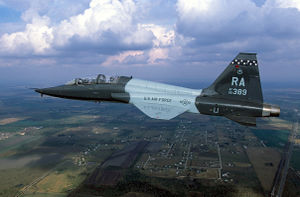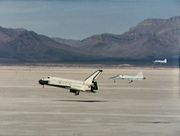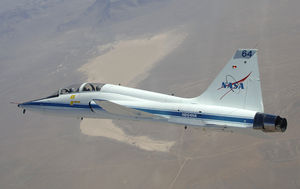Northrop T-38 Talon
| T-38 Talon | |
|---|---|
 |
|
| A USAF T-38A Talon from 560th Flying Training Squadron, Randolph AFB, Texas (USA), flying over the Texas countryside in 2001 | |
| Role | Advanced trainer |
| Manufacturer | Northrop Corporation |
| First flight | 10 March 1959 |
| Introduced | 17 March 1961 |
| Status | Operational |
| Primary users | United States Air Force Turkish Air Force United States Navy NASA |
| Produced | 1961–1972 |
| Number built | 1,187 |
| Unit cost | $756,000 (1961 Constant Dollars) |
| Developed from | N-156 |
| Variants | Northrop F-5 |
The Northrop T-38 Talon is an American supersonic jet trainer. It was the world's first supersonic trainer and to date, is also the most produced. It remains in service as of 2010 in air forces throughout the world.
The United States Air Force (USAF) is the largest user. In addition to USAF pilots, the T-38 is used by United States NASA astronauts, the U.S. Naval Test Pilot School (other T-38s were previously used as USN aggressor aircraft), as well as some NATO pilots participating in a joint training program. A few are also under civilian ownership.
Contents |
Design and development
The basic airframe was used for the light combat aircraft F-5 Freedom Fighter family. In the 1950s Northrop began studying lightweight and more affordable fighter designs. The company began with its single-engine N-102 "Fang" concept.[1] The N-102 was facing weight and cost growth, so the project was canceled and the company N-156 project was begun.[2]
Although the United States Air Force had no need for a small fighter at the time, it became interested in the trainer as a replacement for the T-33 Shooting Star it used at the time in that role. The first of three prototypes (designated YT-38) flew on 10 March 1959. The type was quickly adopted and the first production examples were delivered in 1961, officially entering service on 17 March that year, complementing the T-37 primary jet trainer. When production ended in 1972, 1,187 T-38s had been built. Since its introduction, it is estimated that some 50,000 military pilots have trained on this aircraft. The USAF remains one of the few armed flying forces using dedicated supersonic final trainers, as most, such as the US Navy, use high subsonic trainers.
The T-38 is of conventional configuration, with a small, low, long-chord wing, a single vertical stabilizer, and tricycle undercarriage. The aircraft seats a student pilot and instructor in tandem, and has intakes for its two turbojet engines at the wing roots. Its nimble performance has earned it the nickname white rocket. In 1962, T-38s set four climb records.

The F-5B and F (which also derive from the N-156) can be distinguished from the T-38 by the wings; the wing of the T-38 meets the fuselage straight and ends square, while the F-5 possesses leading edge extensions near the wing roots and wingtip launch rails for air to air missiles. Under the paint, the T-38 wing is constructed of honeycomb material whereas the wing of the F-5 family is constructed of conventional skin over underlying support structure.
Most T-38s built were of the T-38A variant, but the USAF also had a small number of aircraft that had been converted for weapons training. These aircraft (designated AT-38B) had been fitted with a gunsight and could carry a gunpod, rockets, or bombs on a centerline pylon. In 2003, 562 T-38s were still operational with the USAF and are currently undergoing structural and avionics programs (T-38C) to extend their service life to 2020. Improvements include the addition of a HUD, GPS, INS (Inertial Navigation System), and TCAS as well as PMP (a propulsion modification designed to improve low-altitude engine performance by significantly increasing thrust). Many USAF variants (T-38A and AT-38B) are being converted to the T-38C standard.

The fighter version of the N-156 was eventually selected for the US Military Assistance Program (MAP) and produced as the F-5 Freedom Fighter. Many of these have since reverted to a weapons training role as various air forces have introduced newer types into service. The F-5G was an advanced single engine variant later renamed the F-20 Tigershark.
Operational history
Military
The United States Air Force Strategic Air Command had T-38 Talons in service from 1978 through 1991. These planes were used to enhance the career development of bomber co-pilots through the "Accelerated Copilot Enrichment (ACE) Program". They were later used as proficiency aircraft for all B-52 and B-1 pilots, as well as SR-71, U-2, KC-135, and KC-10 pilots.
Air Education and Training Command uses the T-38C to prepare pilots for aircraft such as the F-15E Strike Eagle, F-15C Eagle, F-16 Fighting Falcon, B-1B Lancer, A-10 Thunderbolt and F-22 Raptor. The AETC received T-38Cs in 2001 as part of the Avionics Upgrade Program. The T-38Cs owned by the AETC will undergo propulsion modernization which replaces major engine components to enhance reliability and maintainability, and an engine inlet/injector modification to increase available takeoff thrust. These upgrades and modifications, with the Pacer Classic program, should extend the service life of T-38s to 2020.
Besides the USAF, other T-38 operators include the US Navy, German Luftwaffe, the Portuguese Air Force, the Republic of China Air Force, and the Turkish Air Force.
NASA
NASA uses the plane as a jet trainer for its astronauts, as well as a chase plane. Its fleet is housed primarily at Ellington Field in Houston, Texas.
In the wake of the Space Shuttle Challenger disaster, then-President Ronald Reagan and his wife Nancy traveled to the Lyndon B. Johnson Space Center in Houston, Texas on 31 January 1986, to speak at a memorial service honoring the astronauts. It was attended by 6,000 NASA employees and 4,000 guests as well as by the families of the crew. During the carefully planned ceremony, an Air Force band led the singing of "God Bless America" as NASA T-38 Talons flew directly over the scene in the traditional missing-man formation. All activities were broadcast live by the national television networks.
Civil
Boeing has also used the T-38 as a chase plane. A T-38 was used as a 'lead' plane for the first flight of the 787 Dreamliner, to check ahead on weather conditions.
In addition, there are a very small number in private civilian hands.
Accidents
NASA's T-38s were involved in separate fatal accidents in the 1960s, resulting in the deaths of astronauts Theodore Freeman, Elliot See, Charles Bassett, and Clifton Williams.
In response to the 1973 OPEC oil embargo, from 1974 to 1983, the U.S. Air Force Thunderbirds aerobatic display team adopted the T-38 Talon, which used far less fuel than the F-4 Phantom. The Blue Angels downsized to the A-4 Skyhawk at roughly the same time. After the infamous 1982 "Diamond Crash" incident that killed four of the Thunderbirds' six demonstration pilots, the Talon was replaced in this role by the front-line F-16A Fighting Falcon.
Two fatal crashes in 2008, one on April 23 at Columbus Air Force Base in Mississippi and the second on May 1 at Sheppard Air Force Base in Wichita Falls, Texas, resulted in four fatalities, causing the Air Force to temporarily ground the aircraft.[3] On May 21, 2009, a T-38 crashed just north of Edwards Air Force Base in the Mojave Desert.[4]
Variants
- N-156T : Northrop company designation.
- YT-38 : Prototype, two built, later re-designated YT-38A
- T-38A : Two-seat advanced training aircraft, production model, 1,139 built.
- T-38A(N) : Two-seat astronaut training version for NASA.
- AT-38A : A small number of T-38As were converted into weapons training aircraft.
- DT-38A : A number of US Navy T-38As were converted into drone directors.
- NT-38A : A small number of T-38As were converted into research and test aircraft.
- QT-38A : Unmanned target drone aircraft.
- AT-38B : Two-seat weapons training aircraft.
- T-38C : A T-38A with structural and avionics upgrades.[5]
- T-38M ARI : Turkish T-38 with avionics upgrades.[6]
Operators
- Portuguese Air Force received 12 aircraft in 1977. Initially operated by 201 Sqn. "Falcões" (Falcons) at Air Base No. 5, in 1980 they were transferred to 103 Sqn. "Caracóis" (Snails) being stationed in Air Base No. 11. They were finally retired in 1993.
- Republic of China Air Force has 40 in operation as of January 2009.[7]
- Turkish Air Force has 67 T-38s in use as of November 2008.[8]
- Republic of Korea Air Force: Introduced into service: April 1999. Currently being replaced by the T-50 Golden Eagle supersonic trainer.

- United States Air Force has 459 T-38 trainers in service as of September 2008.[9])
- United States Navy has 10 aircraft in use as November 2008.[8]
- NASA (~32 aircraft)
- Thornton Aircraft Company (~5 aircraft)
Specifications (T-38A)
General characteristics
- Crew: 2: student and instructor
- Length: 46 ft 4.5 in (14.14 m)
- Wingspan: 25 ft 3 in (7.7 m)
- Height: 12 ft 10.5 in (3.92 m)
- Wing area: 170 ft² (16 m²)
- Empty weight: 7,200 lb (3,270 kg)
- Loaded weight: 11,820 lb (5,360 kg)
- Max takeoff weight: 12,500 lb (5,670 kg)
- Powerplant: 2× General Electric J85-5A (J85-5R after PMP modification) afterburning turbojets
- Dry thrust: 2,050 lb (9.1 kN) each
- Thrust with afterburner: 3,850 lbf (17.1 kN) each
Performance
- Maximum speed: Mach 1.3 (858 mph, 1,381 km/h)
- Range: 1,140 mi (1,835 km)
- Service ceiling: 50,000 ft (15,240 m)
- Rate of climb: 33,600 ft/min (170.7 m/s)
- Wing loading: 70 lb/ft² (340 kg/m²)
- Thrust/weight: 0.65
See also
Related development
Related lists
- List of active United States military aircraft
References
- ↑ Johnsen 2006, pp. 5–6.
- ↑ Eden 2004, p. 344.
- ↑ Associated Press, "Planes Grounded After Crashes", printed in the New York Times, May 2, 2008, p. 14.
- ↑ http://www.af.mil/news/story.asp?id=123150668
- ↑ Factsheets : T-38 Talon : T-38 Talon
- ↑ T-38 ARI
- ↑ 7.0 7.1 "World Military Aircraft Inventory". 2009 Aerospace Source Book. Aviation Week and Space Technology, 2009.
- ↑ 8.0 8.1 "Directory: World Air Forces". Flight International, 11–17 November 2008.
- ↑ "The Air Force in Facts and Figures". Air Force Magazine, May 2009.
- http://www.holloman.af.mil/library/factsheets/factsheet_print.asp?fsID=4499&page=1
- Eden, Paul, ed. "Northrop F-5 family". Encyclopedia of Modern Military Aircraft. Amber Books, 2004. ISBN 1904687849.
- Johnsen, Frederick A. Northrop F-5/F-20/T-38. North Branch, Minnesota: Specialty Press, 2006. ISBN 1-58007-094-9.
- Shaw, Robbie. F-5: Warplane for the World. St. Paul, Minnesota: Motorbooks, 1990. ISBN 0-87938-487-5.
External links
- T-38 Talon USAF Fact Sheet
- T-38 Talon page on GlobalSecurity.org
- T-38 Talon page on SR-71.org
- NASA photo gallery
- "White Rocket," Air & Space Magazine, September 2005
|
|||||||||||||||||||||||||||||||||||||||||||||
|
|||||||||||||||||||||||||||||||||||||||||||||||||||||||||||||||
|
||||||||||||||||||||
|
||||||||||||||
